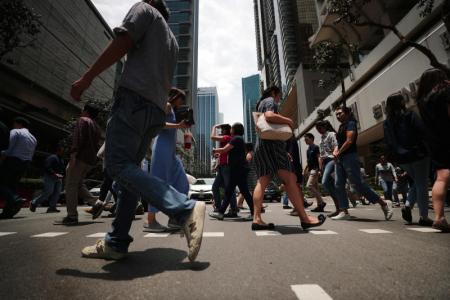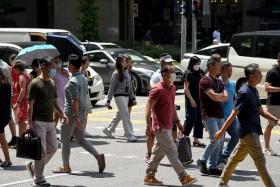Labour market remains 'resilient'
Unemployment at highest since 2009 but jobs growth also highest in 5 years, suggesting widening mismatches
Overall unemployment in Singapore crept up in the third quarter of this year to the highest level since the global financial crisis in 2009, and more workers were retrenched.
At the same time, employment growth shot up to the highest level in nearly five years.
This was the mixed picture painted by the latest preliminary figures on jobs released by the Ministry of Manpower (MOM) yesterday.
Economists said that while the worsening unemployment rates and retrenchments were in line with the economic slowdown, the labour market remained relatively resilient.
The overall seasonally adjusted jobless rate crept up to 2.3 per cent last month, up from 2.2 per cent in June.
The last time the rate was 2.3 per cent was in December 2009, which had come off a peak of 3.3 per cent in September that year.
The rate for Singaporeans rose to 3.3 per cent, from 3.2 per cent, while the rate for citizens and permanent residents combined rose to 3.2 per cent, from 3.1 per cent. These were the highest in more than two years.
Citizen unemployment in June had previously been stated as 3.3 per cent, but was revised down.
Retrenchments rose to 2,900 last quarter, up from 2,320 in the preceding quarter and 2,860 a year ago. Services continued to form the bulk of retrenchments.
However, total employment, excluding foreign domestic workers, rose by 22,400 from July to last month.
This is more than three times the growth of 6,200 in the previous quarter, and higher than the growth of 16,700 a year earlier.
This was largely due to more people finding work in the services sector, though employment also grew in construction and manufacturing.
DBS senior economist Irvin Seah said that the mixed data likely shows the different phases of growth in different industries.
For instance, the technology sector could be doing very well, oil and gas still struggling, construction seeing a broad-based recovery, and manufacturing bottoming out, he said.
The data suggests that mismatches in the labour market are widening, Manpower Minister Josephine Teo said in a Facebook post.
"It could be job seekers not having the skills to access available jobs, or jobs being insufficiently attractive," she said.
Closing the gaps requires both job seekers and employers to be more open and flexible, she added.
Mr Seah noted that the pick-up in unemployment rates suggests that Singaporeans are still facing challenges in the labour market.
Foreigners on work passes typically drop out of the unemployment count as they return home if they lose their jobs.
The growth in service sector employment was mainly in community, social and personal services, professional services and information and communications, said MOM.
The manufacturing sector employed 1,200 more workers, after three consecutive quarters of decline.
With increasing private and public sector construction activities, 5,300 more people were also employed in construction in the last quarter.
Looking forward, National Trades Union Congress assistant secretary-general Patrick Tay said there could be pockets of layoffs and slightly higher unemployment due to restructuring, transformation and digitalisation, coupled with global uncertainties.
Barclays Bank economist Brian Tan said the deterioration in labour market conditions will likely weigh on wage growth.
OCBC Bank chief economist Selena Ling expects the labour market to soften further going into next year.
"I potentially expect more government-targeted assistance for workers in the 2020 Budget," she said.
Get The New Paper on your phone with the free TNP app. Download from the Apple App Store or Google Play Store now



